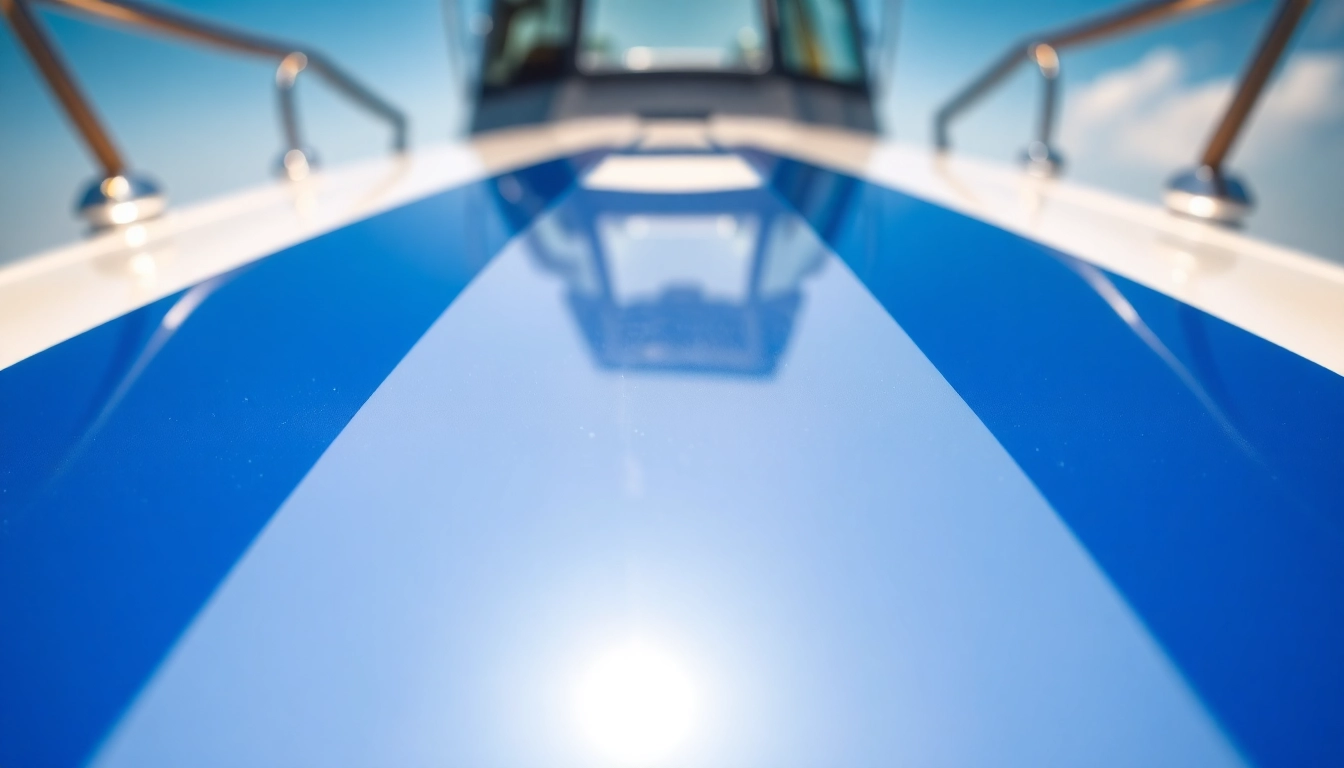Understanding Boots Versiegelung: Benefits and Essentials
Boots Versiegelung, or boat sealant, plays a crucial role in protecting and enhancing the longevity of your marine vessel’s surface. Whether you’re dealing with gelcoat, painted surfaces, or fiberglass, a high-quality sealant acts as a barrier against environmental stressors like saltwater, UV radiation, dirt, and pollutants. Properly applying boots versiegelung not only preserves the aesthetic appeal but also significantly reduces maintenance costs over time. For those looking to achieve a professional finish and maximum durability, understanding the fundamentals of boots versiegelung is essential. To explore top-tier products and techniques, visit our detailed collection of Boots Versiegelung options.
What is Boots Versiegelung and How Does It Work?
Boots versiegelung is a specialized protective coating formulated for marine surfaces. It bonds chemically with the gelcoat or paint layers, creating a semi-permanent or permanent shield against the elements. Modern sealants often leverage advanced polymers or ceramic-based compounds that offer hydrophobic properties, repelling water and preventing the accumulation of dirt and algae. The application involves cleaning and preparing the surface to ensure optimal adhesion. Once cured, the sealant forms a durable film that enhances gloss, reduces surface degradation, and facilitates easy cleaning. Anti-corrosion features further protect metal components attached to the boat, extending their service life.
Key Advantages for Marine Surfaces
- Enhanced Protection: Shields against UV damage, saltwater corrosion, and fouling agents.
- Improved Aesthetic Appeal: Restores and maintains high gloss, ensuring your boat stays attractive and resale value remains high.
- Ease of Maintenance: Surfaces become more resistant to dirt, grime, and algae, simplifying regular cleaning routines.
- Long-lasting Results: Properly applied, some sealants can last several seasons, reducing the frequency of reapplication.
- Environmental Resistance: Better withstands harsh environmental conditions, including temperature fluctuations and pollution.
Common Types of Sealing Products and Their Uses
There are various formulations of boots versiegelung tailored for specific needs:
- Polymer-Based Sealants: Offer excellent durability and UV resistance; ideal for regular maintenance.
- Ceramic Coatings: Provide superior hydrophobic effects and scratch resistance, often with longer reapplication intervals.
- Liquid Waxes: Easy to apply, offering a quick shine boost and protection, suitable for owners seeking simplicity.
- Hybrid Sealants: Combine elements of polymers and ceramics for balanced performance and affordability.
Choosing the right product depends on your boat’s material, environmental conditions, and intended usage.
Step-by-Step Guide to Applying Boots Versiegelung Effectively
Preparing Your Boat Surface for Sealant Application
Preparation is critical for achieving a flawless finish. Begin by thoroughly washing the surface with a dedicated marine cleaner like the BCC Power Cleaner 1L to remove dirt, salt, and organic deposits. Follow with decontamination using clay bars or specialist decontamination products to eliminate embedded impurities. Ensure the surface is completely dry and free from wax residues or previous sealants, which can compromise adhesion. Using a high-quality microfiber towel assists in final drying and inspection.
Application Techniques for Optimal Results
For consistent application, follow these best practices:
- Use a foam applicator pad or a soft microfiber cloth to spread the sealant evenly across the surface.
- Work in small sections to monitor drying times and avoid overlaps or missed spots.
- Apply thin, uniform coats—multiple light layers often outperform a single heavy application.
- Allow each coat to cure according to manufacturer instructions, typically 10–15 minutes between layers.
- Pay special attention to edges and corners for complete coverage.
Careful, methodical application ensures a seamless protective layer that maximizes durability and appearance.
Drying, Curing, and Final Checks
Post-application, the surface requires proper curing to develop full protective properties. Avoid exposure to water or heavy use during this period, which can range from a few hours up to 24 hours depending on the product. Conduct visual inspections for uniformity, gloss, and absence of streaks. If necessary, buff lightly with a clean microfiber towel such as the BCC Microfaser Towel for enhanced gloss. Regularly check for any areas needing touch-up or reapplication, especially after exposure to harsh conditions.
Expert Tips for Maintaining and Reapplying Boots Versiegelung
Routine Cleaning and Inspection
Implement a consistent cleaning routine using gentle marine-specific cleaners complemented by microfiber towels. Regular inspections help identify early signs of sealant wear or damage, such as dullness or water pooling. For stubborn fouling, mild abrasive pads or soft brushes can be used, but avoid harsh scrubbing that may damage the coating.
Reapplication Schedule and Best Practices
Most sealants require reapplication every 1–3 years, depending on usage and environmental exposure. Use a detailed maintenance schedule aligned with your boat’s conditions. Before reapplying, always decontaminate and lightly sand the surface with fine grit sandpaper or polishing pads to ensure proper adhesion. Applying a fresh coat over an aged or contaminated surface diminishes effectiveness; hence, thorough preparation is vital.
Troubleshooting Common Issues
Problems such as streaking, hazing, or uneven gloss may result from improper application, incompatible cleaning products, or environmental factors. Solutions include re-cleaning with appropriate detergents, mild polishing, and reapplication. Ensuring optimal curing conditions—low humidity and moderate temperatures—also prevents surface defects.
Choosing the Right Boots Versiegelung Products for Your Boat
Factors to Consider: Material, Climate, and Usage
Select a sealant tailored to your specific needs. For boats exposed to salty environments, prioritize corrosion-inhibiting formulas. If your vessel spends extended time in the sun, opt for UV-resistant coatings. The material of your boat surface (gelcoat, painted, fiberglass) also influences product choice; some formulations adhere better to certain substrates.
Top Product Recommendations and Features
Among highly recommended products are the MARINE SEALANT MS-3000/60 V2. It offers excellent long-term protection, water repellency, and easy application. Ceramic-based coatings like Gtechniq Marine provide superior hydrophobic effects and scratch resistance, ideal for high-performance boats. For budget-conscious owners, liquid waxes and hybrid sealants provide a good balance of protection and affordability.
Comparing Sealants: Cost, Longevity, and Performance
While ceramic coatings tend to have a higher initial cost, they often last multiple seasons, reducing reapplication frequency. Polymer-based sealants are more affordable upfront but may need reapplication annually. The choice depends on your budget, maintenance preferences, and desired durability. Consider customer reviews and expert opinions to select products that align with your usage profile and climatic conditions.
Innovative Technologies and Future Trends in Boots Versiegelung
Marine-Specific Polymer and Ceramic Coatings
Recent advancements include nanotechnology-enhanced coatings that provide superhydrophobic properties and self-healing capabilities. These products form a durable, chemical-resistant barrier, lowering maintenance efforts and protecting against micro-scratches. Such innovations are shaping the future of boat maintenance, promising longer-lasting, eco-friendly solutions.
Eco-Friendly and Sustainable Sealant Options
Growing environmental awareness has spurred the development of biodegradable, solvent-free sealants that deliver high-performance protection without harming aquatic ecosystems. These formulations reduce volatile organic compounds (VOCs) and are safer for operators and marine life.
Emerging Applications for Enhanced Durability
Future trends include integrating UV stabilizers, anti-fouling agents, and anti-microbial components directly into sealant formulations. These innovations aim to extend the lifespan of marine surfaces, reduce cleaning frequency, and improve resistance to biofouling, ultimately maximizing your vessel’s efficiency and appearance.

